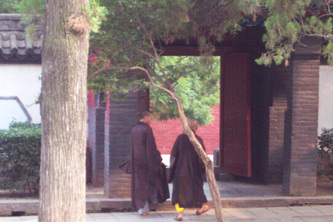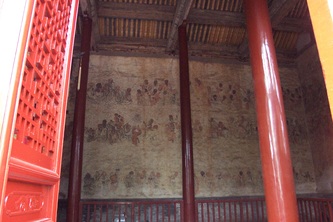Shaolin History of Five Animal Kenpo.
Fourteen hundred years ago a Buddhist monk from India, Tamo, traveled to China. Credited with being the founder of Zen and the father of kung-fu, Tamo eventually found a home for his teachings at the Shaolin Monastery in the Hunan Province of China. According to legend, Tamo was quite unsatisfied with the concentration and fitness of the disciple monks at the monastery. Tamo instructed the monks in various exercise patterns, including the Muscle Change Classic. These patterns, which likely borrowed from the warrior caste yoga systems of India, were methods of developing physical fitness and increasing vital energy. Tamo's methods would serve as a foundation for future generations to build upon.
How could monks, who lived simple lives, had few desires, avoided conflict, and revered all life become the epicenter for the development of the martial arts for generations to come? Some have speculated that the monks, in their travels, were easy targets for bandits and thus developed methods of fighting as a defense to these threats. Although this is possible, it seems strange that the art would progress to such extreme levels for the sake of protecting against bandits. Another influence on the temple's progression of the fighting arts was from visiting military officials who were political refugees. Those visiting would share knowledge and advance the Shaolin combative methods.
In Zen, all answers can ultimately be found within. Enlightenment is not the result of acquiring knowledge, but of simply seeing the unclouded divinity of oneself. Free from ego, detached from attainment, unrestricted by self, one who has seen his pure nature has seen the universe. Thus, to a Shaolin Monk, all actions ultimately must be towards the eventual attainment of enlightenment. Punching, kicking, blocking, and wielding weapons does not on the surface seem to be a path of enlightenment, but instead seems to be a path of violence and war. Indeed, to the military visitors of Shaolin, it was a path of war they had traveled. To the true monk, however, the martial arts, like painting, sculpture, calligraphy, striking a gong, or eating a bowl of rice, were an act of mindfulness to reach enlightenment.
Martial arts, exactly because of its extreme physical demands and mental concentration, is an ideal tool for the Zen student to meditate while in motion. As the body spins, the leg extends, the hand blocks, the mind empties and clears. It is in the "empty mind", not the fighting skill itself, where a monk finds the fruit of the labor of his training. In learning methods of apparent outward violence, the monk is seeking inner peace. With inner peace, comes outward peace, thus having no need to utilize the skills of destruction which the monk has perfected. It is not a contradiction to learn an art of apparent violence, if you live an art of actual peace. Discard the delusion to find the reality!
As the art form of Shaolin developed and progressed, eventually the movements were categorized into five styles: Dragon, snake, tiger, leopard, and crane. These five animal methods became the foundation of Shaolin Chuan Fa, with each animal specializing in a different strategy of combat, style of movement, and attitude of spirit.
Five Animal Kenpo is a modern method of self-defense, historically linked to the Shaolin tradition. Like the Shaolin methods of old, our approach utilizes the imagery of the five animals to organize our fighting techniques, strategies, and attitude of spirit. As with Shaolin, learning is based upon progressive stages of learning, organized into thirty-six chambers. As with Shaolin, the fighting methods are secondary to personal development.
Shaolin History of Five Animal Kenpo (c)1999 Trevor Haines
How could monks, who lived simple lives, had few desires, avoided conflict, and revered all life become the epicenter for the development of the martial arts for generations to come? Some have speculated that the monks, in their travels, were easy targets for bandits and thus developed methods of fighting as a defense to these threats. Although this is possible, it seems strange that the art would progress to such extreme levels for the sake of protecting against bandits. Another influence on the temple's progression of the fighting arts was from visiting military officials who were political refugees. Those visiting would share knowledge and advance the Shaolin combative methods.
In Zen, all answers can ultimately be found within. Enlightenment is not the result of acquiring knowledge, but of simply seeing the unclouded divinity of oneself. Free from ego, detached from attainment, unrestricted by self, one who has seen his pure nature has seen the universe. Thus, to a Shaolin Monk, all actions ultimately must be towards the eventual attainment of enlightenment. Punching, kicking, blocking, and wielding weapons does not on the surface seem to be a path of enlightenment, but instead seems to be a path of violence and war. Indeed, to the military visitors of Shaolin, it was a path of war they had traveled. To the true monk, however, the martial arts, like painting, sculpture, calligraphy, striking a gong, or eating a bowl of rice, were an act of mindfulness to reach enlightenment.
Martial arts, exactly because of its extreme physical demands and mental concentration, is an ideal tool for the Zen student to meditate while in motion. As the body spins, the leg extends, the hand blocks, the mind empties and clears. It is in the "empty mind", not the fighting skill itself, where a monk finds the fruit of the labor of his training. In learning methods of apparent outward violence, the monk is seeking inner peace. With inner peace, comes outward peace, thus having no need to utilize the skills of destruction which the monk has perfected. It is not a contradiction to learn an art of apparent violence, if you live an art of actual peace. Discard the delusion to find the reality!
As the art form of Shaolin developed and progressed, eventually the movements were categorized into five styles: Dragon, snake, tiger, leopard, and crane. These five animal methods became the foundation of Shaolin Chuan Fa, with each animal specializing in a different strategy of combat, style of movement, and attitude of spirit.
Five Animal Kenpo is a modern method of self-defense, historically linked to the Shaolin tradition. Like the Shaolin methods of old, our approach utilizes the imagery of the five animals to organize our fighting techniques, strategies, and attitude of spirit. As with Shaolin, learning is based upon progressive stages of learning, organized into thirty-six chambers. As with Shaolin, the fighting methods are secondary to personal development.
Shaolin History of Five Animal Kenpo (c)1999 Trevor Haines


